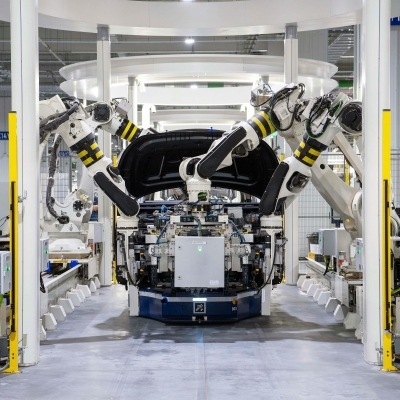Load Cell Amplifiers
Digital Load Cell Amplifier, 4-20mA/0-10V/RS485 Output
Load Cell Transmitter, 4-20mA/0-5V/0-10V Output
Load Cell Weight Transmitter, 0-5V/0-10V/4-20mA Output
Load Cell Transmitter with TEDS, 3/6/9 Channel
Load Cell Junction Box, Multiple Inlets to One Outlet
Wireless Load Cell Transmitter and Receiver, 100m, 80Hz
A load cell amplifier is a key electronic device that connects a load cell to a data acquisition, display, or control system. Because the electrical signal output by a load cell is typically extremely weak and susceptible to external interference, the load cell transmitter's core function is to amplify, filter, and condition this weak signal, converting it into a stable, standard electrical signal that allows subsequent equipment to accurately read and process physical quantities such as weight, force, or pressure. SUCH online store offers different types of load cell amplifiers that can output different standard signals: 0-5V/0-10V/4-20mA0-5V/0-10V/4-20mA/RS485.
Working Principle of Load Cell Amplifiers
The working principle of a load cell amplifier is to condition the weak signal output by the load cell and ultimately convert it into a stable and usable standard signal. First, when a load cell is subjected to external forces, the internal strain gauge deforms, causing a change in resistance. This changes through a Wheatstone bridge circuit, generating a weak differential voltage signal. The amplifier's input receives this differential signal to reduce common-mode interference. The signal then enters a low-noise preamplifier circuit, where a high-precision operational amplifier initially amplifies the weak signal to tens to hundreds of millivolts. This process requires strict control of noise input to prevent subsequent signal distortion. The amplified signal then passes through a filtering circuit to remove external electromagnetic interference, power supply noise, and other clutter, retaining only the useful signal related to the external force change. A linearization circuit or software algorithm then corrects for any nonlinear deviations in the sensor output. Zero and gain calibrations are also performed to ensure a strict linear relationship between the signal and the actual external force. Finally, the processed signal is converted into an industrial standard signal, such as a 0-5V or 0-10V voltage signal, a 4-20mA current signal, or a digital signal such as RS485 or Modbus. This allows subsequent devices, such as PLCs, dashboards, and computers, to accurately read, display, and process the weight or force data.
Advantages of Load Cell Amplifiers
- Improving Signal Strength: The raw signal from a load cell is weak (mV level). Direct transmission or acquisition can easily be overwhelmed by noise, leading to measurement errors. The load cell amplifier amplifies the signal to a standard level, enabling subsequent equipment to accurately detect minute weight changes and meet high-precision measurement requirements.
- Interference Suppression: Industrial environments are subject to significant electromagnetic interference, power supply fluctuations, and ground noise, which can directly affect the load cell signal. The load cell transmitter's differential input design, filtering circuitry, and isolation technology effectively block interference sources, ensuring signal stability even after long-distance transmission and preventing measurement data fluctuations.
- Compatible with Various Devices: Different downstream devices have varying signal input requirements. The load cell amplifier can output a variety of standard signals (0-10V, 4-20mA, RS485, etc.), eliminating the need to replace sensors or modify equipment, reducing system integration costs.
- Compensating for Environmental Impacts: Load cell output is susceptible to environmental factors such as temperature and humidity. The load cell amplifier features built-in temperature compensation, which monitors environmental changes in real time and corrects signal deviations, ensuring consistent measurement results in diverse environments.
Applications of Load Cell Amplifiers
- Production Line Weight Monitoring: In food, pharmaceutical, and chemical production lines, load cell transmitters work with sensors to monitor material weight, ensuring consistent product specifications and preventing overweight or underweight.
- Force-Controlled Assembly Processes: In automotive and electronics manufacturing, the load cell amplifier is used to monitor assembly force. The amplifier amplifies the sensor signal and transmits it to the PLC. If the force exceeds the threshold, the system immediately shuts down to prevent component damage.
- Conveyor Scale/Hop Scale Metering: In the mining and building materials industries, conveyor scales and hopper scales require amplifiers to process signals for continuous metering and batching control.
- Material Mechanics Testing: In materials science research, tensile and compression testing machines use sensors to measure the tensile and compressive strength of materials. Amplifiers amplify the weak signals and analyze the material properties using the data.
- Automobile Weighing Systems: Scales at truck overload detection stations use amplifiers to amplify signals and transmit them to a control center, displaying the truck's gross weight in real time to determine overload status.
- Automotive Component Testing: In automotive R&D, load cell sensors measure friction and damping forces. Load cell amplifiers process the signals to analyze component durability and performance.

Automobile Weighing

Force Controlled Assembly
























